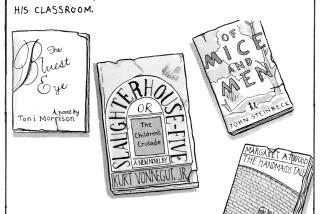Five totally immoral books besides ‘Fun Home’ Duke University students should also skip

This week, some students at Duke University, seen here, said they wouldn’t read optional summer book — Alison Bechdel’s graphic novel “Fun Home” — because it could compromise their religious beliefs.
- Share via
A group of Duke University students made headlines after announcing they wouldn’t read Alison Bechdel’s 2006 graphic memoir, “Fun Home,” because of its “graphic visual depictions of sexuality.”
The book is part of Duke’s Common Experience Summer Reading Program, in which the university selects a single book to be read by all incoming first-year students — a way of giving everyone a “shared intellectual experience.” (The reading is optional.)
But a Facebook status update by one first-year student, Brian Grasso, led some students to rally behind a boycott because of the book’s (brief) depictions of masturbation and lesbian sex.
Never mind that the depictions are hardly titillating, and the book is primarily about a young woman’s coming of age and the suspected suicide of her father. (The university has defended the selection, stating that it hoped students would begin their university education “with open minds and a willingness to explore new ideas, whether they agree with them or not.”)
Grasso says he would have read the book if it had been just text. It’s the drawings, in his mind, that veer into pornography.
But how different are images on the page from images created by words in your head? (I’ve still got that heads-on-spikes scene from Joseph Conrad’s “Heart of Darkness” occupying my brain after reading it in high school. And forget about all that Judy Blume.)
To help preserve the morality of Duke University’s incoming first-years (or anyone who might have trigger issues), I’ve compiled a helpful list of five books to avoid at all costs due to the graphic nature of their content — dirty, filthy, raunchy books teeming with sex and death.
1. “Oedipus the King”
As part of a prophecy, a young Oedipus kills his father, Laius, marries his mother, Jocasta, and has children with her (children who, technically, are also his half-siblings). She finds out and hangs herself. He wants to cut out her womb with his sword but uses her brooches to gouge out his own eyeballs instead. It’s a classic of the Western canon, replete with incest and murder — not to mention gory eyeball violence: “With every blow blood spurted from his eyes, down on his beard, and not in single drops, but showers of dark blood spattering like hail.”
Trying getting a good night’s sleep now.
2. “MacBeth”
Where to begin with this steaming pile of turpitude? MacBeth is William Shakespeare’s murder-happy nobleman, who, with the egging on of his wife, Lady MacBeth, kills the King of Scotland, takes his job and then gets around to mercilessly slaughtering anyone who might be suspicious of him: the king’s guards, his pal Banquo and the wife and child of his fellow Thane, MacDuff. In the process, Lady MacBeth loses it and commits suicide. Also, there are witches. (Totally satanic.) In fact, this book is so morally dubious, I’d suggest not even reading this summary.
3. “Anna Karenina”
A thousand pages dedicated to marriage infidelity? That’s what 19th century Russian novelist Leo Tolstoy produced in this indecent tale about a married woman who begins a torrid affair with a dapper count named Vronsky, becoming pregnant in the process. She leaves her husband to run off with the Count, but, ultimately, doesn’t find happiness in his arms. The book ends in tragedy (spoiler alert), with Karenina under a train.
“Anna Karenina” has been reimagined over the decades in both English and Russian as feature films and made-for-TV movies (one of which starred “Superman” Christopher Reeve as the amorous Vronsky) plus several television miniseries. Definitely do not read or watch these — especially not the lauded 1935 version of the film that stars none other than Greta Garbo.
4. “One Hundred Years of Solitude”
This multigenerational epic by Gabriel García Márquez is rife with all kinds of questionable and corrupting behavior. For one, there are the sundry murders: Patriarch José Arcadio Buendía kills someone in a duel, the children of Col. Aureliano Buendía die by the hand of unknown assassins and a debauched wannabe priest is dispatched in the bath by a group of young adolescents.
But the deaths are nothing compared to all the sex. The book chronicles countless affairs, out-of-wedlock births (17 of them by one man alone), brothers sharing a mistress and a man with an oversized sex organ (“like a turkey’s wattles”) who employs it on a stunning array of women, including the town fortune teller (satanism, again). And, of course, there’s the uncomfortable number of intermarriages and sexual relations between close and distant family members, leading to the constant fear that the lack of genetic variety might produce a child with a pig’s tail.
The whole thing is not only rife with incest, it smacks of evolution. If you own a copy of this book, lock it away.
5. The Bible
Where to begin? The story begins with an unmarried naked couple running around a jungle — and then it just goes downhill from there. A brother kills a brother. A married guy sleeps with his housekeeper (with the permission of his wife). Entire cities ooze wickedness and corruption. And there is murder. There is rape. There is pillage. There are golden idols. There is a whole lot of begatting. There is even Edward G. Robinson betraying Charlton Heston. Oh, wait ... that last part is from the 1956 movie “The Ten Commandments.”
Either way, a book with this much questionable human behavior couldn’t possibly be any good for innocent young minds — especially all those illustrated versions. Whatever you do, DO NOT even think of looking at comic master R. Crumb’s take on the Book of Genesis or you may see some of this human drama in pen and ink.
If you would like a more comprehensive list of books that likely contain treacherous levels of sex, betrayal and violence, I’d suggest starting with the Guardian’s list of the “100 Greatest Novels of All Time.”
Find me on Twitter @cmonstah.
More to Read
The biggest entertainment stories
Get our big stories about Hollywood, film, television, music, arts, culture and more right in your inbox as soon as they publish.
You may occasionally receive promotional content from the Los Angeles Times.











